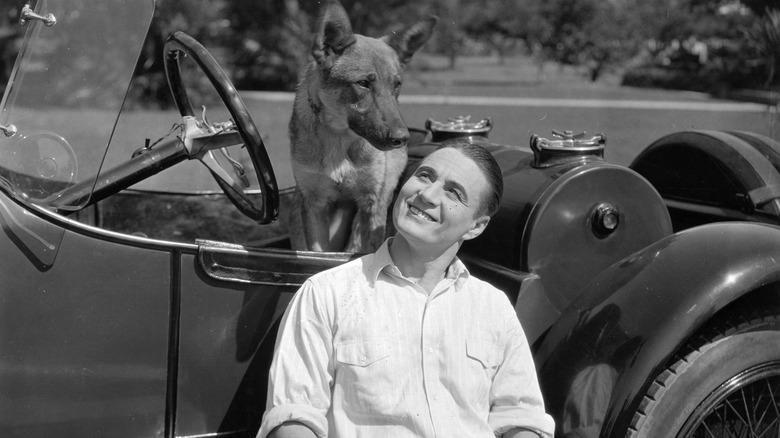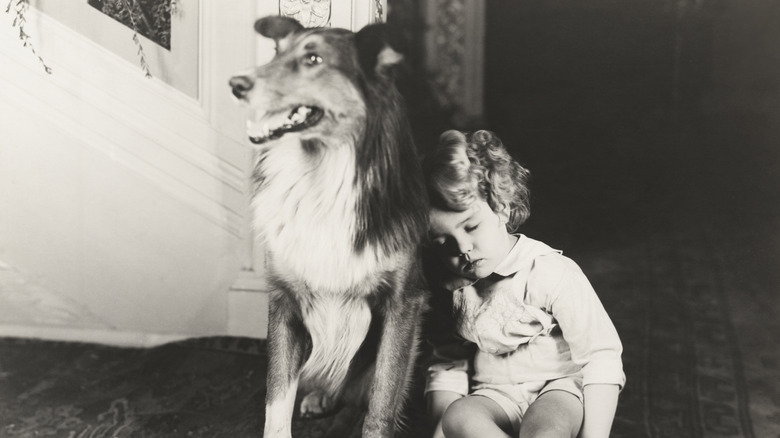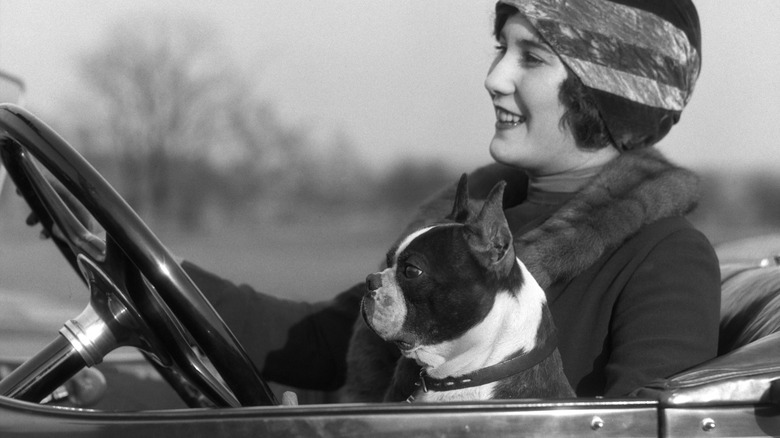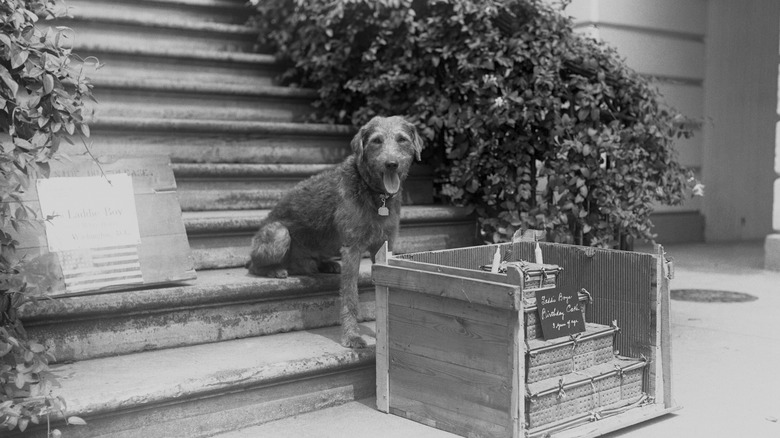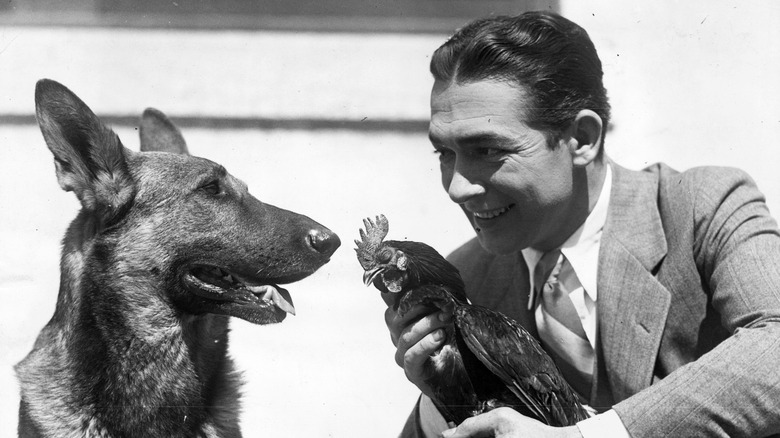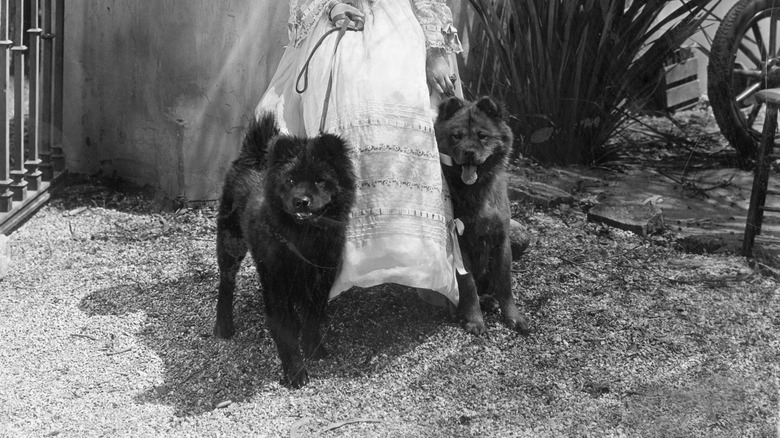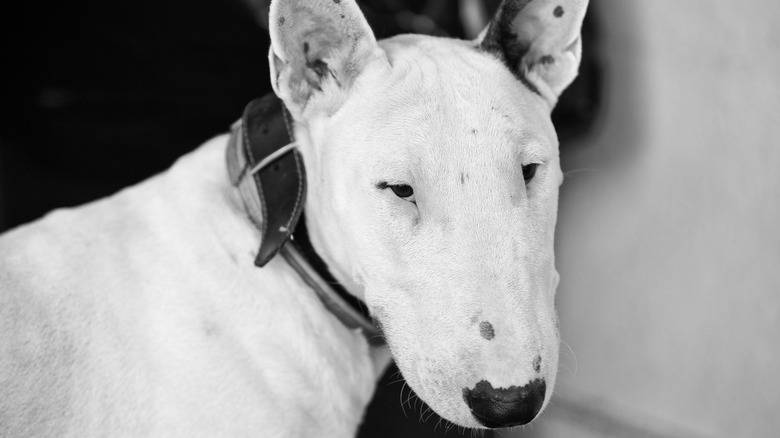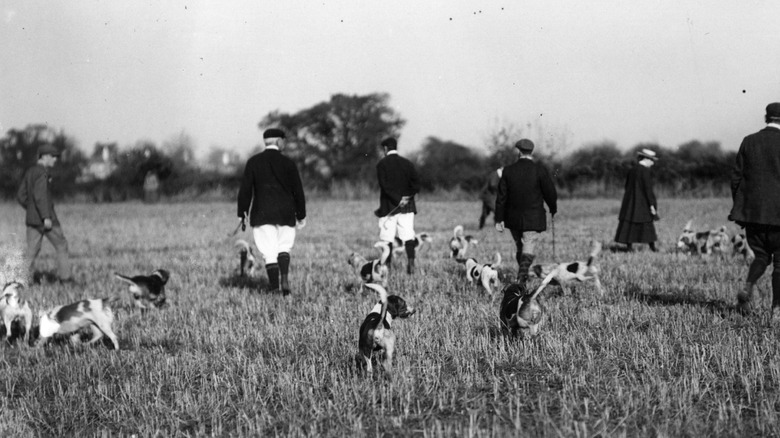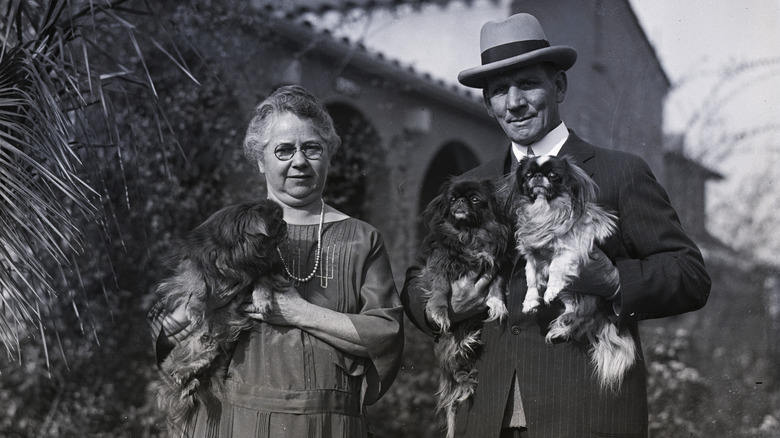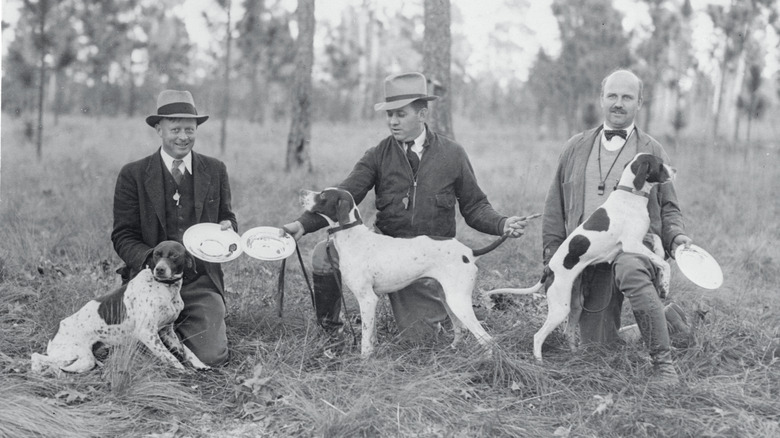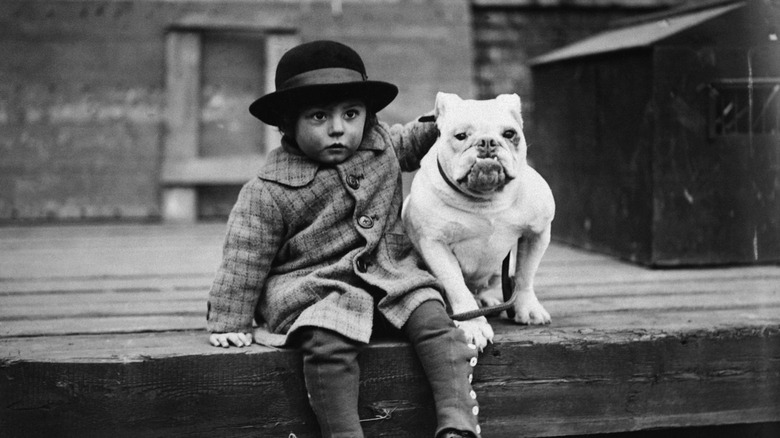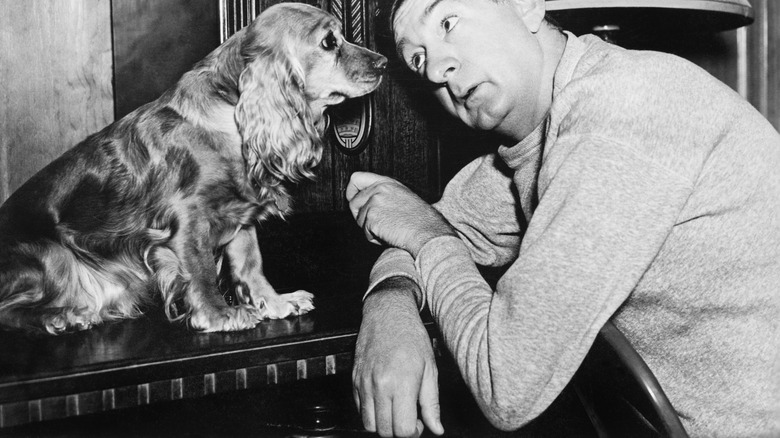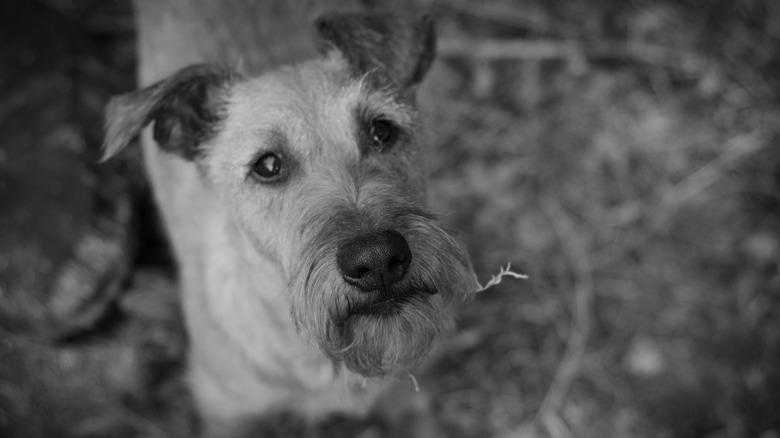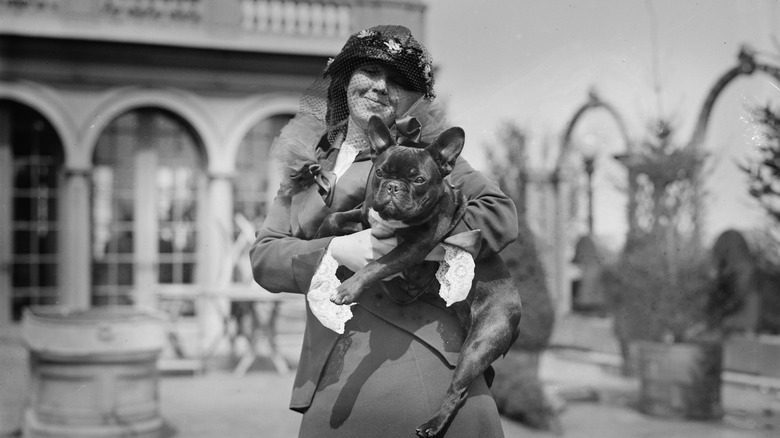The Dog Breeds That Were The Most Popular In The Early 1900s
Getting a dog in the early 1900s was a very different process from what it's like today. For one, the options were much different. Today, there are countless new dog breeds that did not exist at the turn of the 20th century. These include Australian sheepdogs and Belgian Malinois, as well as designer mixes like Labradoodles and Puggles that hadn't even been dreamed of yet.
Families looking to adopt a dog in the 20th century also had vastly different needs compared to today's hopeful adopter. At the time, dogs were expected to provide more than just companionship; they needed to help out with the family's chores and labor. For this reason, many sought out herding and working dogs with specialized breeding for a practical skill.
Since its creation in 1884, the American Kennel Club has compiled lists of the most popular breeds during certain years during the number of registrations received. Looking at this data can give interesting insights into which dog breeds were the most popular at that time and why.
Collie
At the turn of the 20th century, collies were undoubtedly the most popular dog breed in America, in no small part due to their versatility as both efficient farm workers and great family pets. Originating in Scotland, collies have a long history as sheep herding dogs with roots as far back as the Bronze Age. In fact, their name is derived from the Scottish word for a black-faced sheep: colley.
Collies made their way out of Scotland in the second half of the 19th century, appearing in England's first dog show in 1859 and gaining further publicity as one of Queen Victoria's favored breeds in the 1860s. John Pierpont Morgan, founder of the bank JPMorgan Chase, is ultimately credited with their American debut; in 1893, he built a $1 million kennel in New York and began breeding collies he had imported from England. It didn't take long for the entire country become totally enamored.
As the decades passed, collies eventually lost their top spot as other breeds like Boston terriers and German shepherds gained favor. They still remained within the top ten, however, ranking third most popular in the 1910s and sixth most popular in the 1920s. The breed would go on to explode in popularity once again upon the release of "Lassie", a film about a collie who stole the nation's hearts and arguably remains the most famous dog in history.
Boston terrier
The American-bred Boston terrier was an incredibly popular breed in the early 1900s, ranking first in the 1910s and the second in both the 1900s and 1920s. Canine enthusiasts in Boston had only recently created the breed in the second half of the previous century by crossing white English terriers with English bulldogs. For quite some time, there seemed to be widespread disagreement on their name; written materials from this era refer to them under a variety of pseudonyms including roundheads and American bull terriers. This was ultimately settled in 1891 upon the creation of the official Boston Terrier Club of America.
Nicknamed "The American Gentleman", the Boston terrier became an esteemed companion for the rising middle class at the turn of the 20th century. These small pups weigh just 12 to 25 pounds on average, making them excellent apartment-friendly pets for the skyrocketing urban population at the time (it also didn't hurt that they were one of the best behaved dog breeds). But above all, their spunky personality and loving nature are what really made the Boston terrier one of America's most-loved canines.
Airedale terrier
Airedale terriers peaked in popularity as the second most registered breed in the 1910s, coming in eighth in both the 1900s and 1920s. At the time, Airedale terriers held a reputation as the Swiss army knife of dog breeds, both willing and able to help working class families with a wide range of household tasks. While many popular early 20th century dogs had been bred to assist with specific jobs like sheep herding or hunting, Airedale terriers were skilled at everything from pest control to guarding farm animals, providing a more economical option to families who couldn't afford more than one dog.
These helpful companions also played pivotal roles behind the front lines during World War I. Soldiers trained Airedale terriers to carry messages and supplies, even outfitting them with their own gas masks. The breed also proved incredibly valuable to the Red Cross, which trained these heroic pups to sniff out injured soldiers and alert medical staff, potentially saving countless lives.
German shepherd
German shepherds rose to popularity quickly, becoming the number one most popular breed among American Kennel Club registrations in the 1920s. This may have something to do with the reputation this breed developed as wartime heroes during World War I. As their name alludes, German shepherds primarily served alongside German soldiers during the war, leading to some initial resistance from the United States and its allies to accept the breed. In fact, the German Shepherd Dog Club of America was even temporarily renamed to the Shepherd Club of America during this time.
After the war's end in 1918, however, American soldiers who had been impressed by the German shepherd's skill and demeanor brought the breed home in droves. There, they began to train them for other canine careers like guard duty and police work. German shepherds also became a preferred choice for seeing eye dogs trained to help war veterans, marking an important moment in the history of service dogs.
German shepherds were further popularized in Hollywood through the Rin Tin Tin movie series. An American soldier serving in Germany had adopted a German shepherd puppy, who he named Rin Tin Tin, and trained him to perform impressive tricks upon discovering his remarkable intelligence. Warner Bros. capitalized on the pup's talents, making dozens of films in which he and a succession of gifted shepherds starred as a fearless vigilante.
English setter
English setters were the third most popular dog breed in the 1900s and the seventh most popular in the 1910s, but they'd been a household staple for centuries. Evidence of English setters in recorded history dating back to the 14th century indicates that the breed was a common companion for bird hunters. They most likely descend from various pointer and spaniel breeds.
For many centuries, English setters would work in partnership with hunters to drive birds into large nets. This all changed when guns were introduced towards the end of the 18th century. In the decades that followed, they were bred more carefully to remain calm during loud gunfire. American breeders soon began to bring English setters into their own kennels, recognizing the value they might bring to the young nation's hardworking families. In 1878, the English setter became one of only nine breeds to initially be recognized by the newly established American Kennel Club.
Chow chow
Chow chows are one of the oldest dog breeds in existence; their 2,000-year history stretches all the way back to China's Han dynasty. But they gained a sudden surge in popularity in the 1920s, rapidly becoming the third most registered breed during that decade. While many factors were likely at play, the most plausible explanation boils down to the world's obsession with British royalty.
The first chow chows made their way from China to the western hemisphere aboard trading ships during the 1700s. Records show that the London Zoo exhibited some of the dogs as an exotic attraction in the 1820s, indicating that they were still somewhat of a novelty. Ultimately, it was Queen Victoria who made the ancient breed fashionable upon taking one as a pet shortly before the turn of the 20th century.
The American Kennel Club granted official recognition to the chow chow breed in 1903, kicking off its rapid rise to notoriety in the United States. Perhaps most noteworthy is that the breed wasn't known for performing a specific household function like hunting or herding. In fact, chow chows are considered to be one of the dog breeds that requires the least work due to their low exercise requirements. This illustrates a larger shift towards viewing family dogs solely as companions instead of task-based workers.
Bull terrier
A relatively new dog bred in the early 1800s from an amalgam of bulldogs, white English terriers, Dalmatians, and other breeds, bull terriers were originally intended to be fighting dogs at a time when the sport was not only accepted but also fashionable. Thankfully, Britain banned the practice in 1835. By the end of the century, breeders had rebranded the bull terrier as a gentlemanly companion and began to focus more on their unique physical features than their fighting abilities.
After earning American Kennel Club recognition in 1885, bull terriers soon grew in popularity across the United States. Frequent depictions of the breed as a fashionable accessory for aristocratic men led them to become trendy house pets for middle-class families hoping to convey wealth. But like many trends, their status was short lived; while bull terriers were the fourth most popular breed in the 1900s, they quickly fell to 10th most popular in the 1910s before falling off the list entirely.
Beagle
Beagles steadily fluctuated among the top 10 most popular breeds throughout the early 20th century, ranking ninth in the 1900s, fourth in the 1910s, and seventh in the 1920s. This historic breed appears in British literary works dating back to 1475 and was one of the earliest dogs to be brought to the United States, likely arriving sometime in the early 19th century. The modern version of the American beagle was bred shortly after the Civil War, achieving American Kennel Club recognition in 1885.
Early 1900s families loved beagles for their versatility. They excelled equally as both hunting dogs and loving family pets. Generally speaking, this dog breed is known for having one of the best temperaments, with beagles often described as happy-go-lucky while their giant brown eyes express a range of emotions. After steadily holding a place among America's 10 most popular breeds for several decades, beagles would eventually earn the number one spot by the middle of the century.
Pekingese
The Pekingese is a small, unique dog that slowly took hold of American families' hearts throughout the early 1900s, ranking ninth on AKC's most popular breed in the 1910s and rising to fourth place in the 1920s. Originally kept by Chinese royalty, these tiny lion dogs were painstakingly bred for thousands of years to ensure homogeneity. Their arrival in England and the United States at the end of the 19th century is commonly attributed to the Second Opium War, during which soldiers British soldiers pilfered a group of five Pekingese from a burning palace. The dogs were brought to England and presented to Queen Victoria and other members of the aristocracy, making them an instant trend.
It didn't take long after their arrival in the West for Pekingese to become beloved companions among the rising middle class. A massive influx of inhabitants in urban centers generated huge demand for low-maintenance dogs that were small enough to keep in an apartment, and the Pekingese was one of the first toy breeds that could fill the gap. In the absence of the imperial family's strict breeding protocol, however, their physical appearance quickly began to change; their faces and legs are now significantly shorter and their hair longer compared to the dogs who originally departed from China.
Pointer
One of the first breeds to be officially registered in the United States, pointers were the country's fifth most popular dog in the 1900s. Admired for its intrinsic hunting abilities, the pointer was originally brought from Spain to England in the mid-17th century before its introduction to the United States roughly 100 years later. While the breed's origin isn't quite clear, some speculate that it may date back as far as the Middle Ages or even ancient Egypt.
Pointers get their name from their natural instinct to freeze in a straight line and lift their paw upon spotting prey, almost as if they were pointing in its direction. This skill was incredibly useful to early 1900s families who relied on hunting to put food on the table. However, pointers soon declined in popularity and fell off the list of top 10 most popular breeds from the 1910s onwards. Families began choosing breeds for companionship instead of skill around this time, meaning they no longer required the pointer's special abilities.
Bulldog
The Bulldog breed unfortunately has a checkered past that stems from bull-baiting, a practice that involved forcing dogs to attack a bull before it was butchered. Because many animals were sadly injured and killed during bull-baiting, participants began to select sturdier dogs with a better chance of survival, leading to the eventual breeding of the earliest bulldogs.
Once the Cruelty to Animals Act went to effect in 1853 (effectively outlawing bull-baiting), the demand for bulldogs steadily declined until the breed became nearly extinct. Towards the end of the 19th century, however, enthusiasts began to breed a new type of bulldog — this time with the goal to create a docile family pet. The bulldog's appearance changed drastically during this era, gaining its now-trademark droopy face. Overall, the experiment was a success; by the early 1900s, the bulldog's reputation had transformed from a ferocious fighting animal to a popular, sweet-tempered dog for families with kids. Bulldogs reached their apex in popularity as the fifth most registered American Kennel Club breed in the 1910s, later making the top 10 list again during the 1920s.
Cocker spaniel
The cocker spaniel was one of America's favorite dogs throughout not just the early 1900s, but the entire 20th century. According to AKC, the breed ranked sixth in popularity during the 1900s and remained in the top 10 throughout the 1910s and 1920s, eventually reaching the top spot during subsequent decades. The smallest of the sporting breeds, cocker spaniels were first bred for bird hunting but effectively retired as family pets once guns were introduced in the mid-1800s.
Cocker spaniels count themselves among the handful of charter breeds immediately granted recognition upon the American Kennel Club's establishment in 1878. Their popularity rose gradually and unwaveringly in the U.S. and around the world, striking a note with families that had been searching for a docile, child-friendly companion. Cocker spaniels remain a cherished breed to this day; their admirers say their expressive eyes and silky ears make them the ultimate lap dog companion. The breed is notably diverse with dozens of different colors and patterns.
Irish terrier
Generally considered to be the oldest terrier breed still around today, Irish Terriers were an established favorite on Ireland's sprawling farms. Both highly intelligent and eager to please their humans, these lively pups excelled in critical tasks like keeping the house free from pests and protecting the farm's land and animals. Their wiry coat was resistant to shedding and required minimal maintenance care, likely earning the breed favors among the country's homemakers.
After a long history as utilitarian field workers, Irish terriers made a fast debut at dog shows in the late 1800s. The resulting Irish Terrier Club is credited with banning ear cropping not just for Irish Terriers but all dog breeds. Popularity picked up quickly upon arrival in America around the turn of the 20th century, but the breed became less popular in subsequent decades as the need for farm dogs dwindled and demand rose for more fashionable, city-friendly toy breeds. Overall, AKC claims that Irish Terriers were the 10th most popular dog in the 1900s.
French bulldog
French bulldogs claimed the title of America's favorite dog breed in both 2022 and 2023, but this wasn't their first time in the spotlight. Frenchies were also the sixth most popular dog in the 1910s, per AKC.The breed's momentum began in France during the 1890s as common pets among working class women — women who worked in brothels, to be precise — who didn't have the space or budget for a larger dog. The women became so attached to their beloved French bulldogs that the pups would often appear in the spicy photographs they took to print on postcards.
The dog's popularity continue to grow through the following decades, making an appearance at Westminster for the first time in 1896. Soon, American tourists traveling to Europe became enraptured by the French bulldogs they saw and couldn't resist bringing one home. One such dog, a Frenchie named Gamin de Pycombe, was on the Titanic's ill-fated maiden voyage after being picked up in England by his new owner. Tragically, Gamin de Pycombe never reached his new American home.
